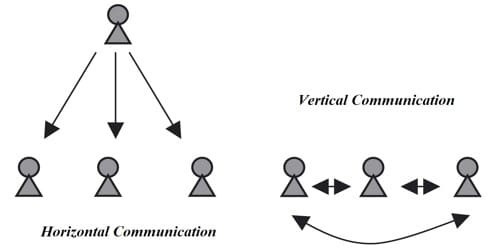Differences between Horizontal and Vertical Communication
Horizontal and vertical communications are the two different types of internal communication. These two types of communications differ in the following ways:
Horizontal Communication
- Meaning: When information flows between persons holding the same position in the organization, it is called horizontal communication. In the case of horizontal communication, information are exchanged of a similar level of an organization. Such communication flows between people at a similar level.
- Purpose: The purpose of horizontal communication is to coordinate the activities of various departments and divisions of the organization.
- Information flow: In this communication, information flows between people holding the same ranks and status. The communication flows here like a straight line. This type of communication more dependent on oral media.
- The degree of formality: Horizontal communication enjoys a greater degree of informality. It can use both formal and informal channels of communication.
- Method of communication: Horizontal communication is mostly done through oral media. This communication is very appropriate for such communication as sender and receiver belong to a similar level.
- The possibility of distortion: Messages of horizontal communication are usually free from distortion.
- Length of communication line: Horizontal communication occurs is a short line as it happens directly between sender and receiver. As both formal and informal channels are followed, information can be exchanged faster than vertical communication.
- Coordination: Such communication helps in coordination between diverse departments of an organization. Co-ordination between the employees of dissimilar departments increased through horizontal communication. In this case, maintaining secrecy is difficult.
Example: Communication between purchase and sales manager.
Vertical Communication
- Meaning: When communication occurs between superiors and subordinates, it is called vertical communication. When information is exchanged between superiors and subordinates of an organization then it is known as vertical communication. Such communication flows between people of dissimilar levels.
- Purpose: The purpose of vertical communication is to provide necessary orders, instructions, and directives to the subordinates in the downward direction and receiving a suggestion, opinion and feedback from the subordinates in the upward direction.
- Information flow: In this communication, information flows from superior to subordinates and vice-versa. It may flow as an upward or downward way. It may use both written & oral media but basically uses the written media.
- The degree of formality: Vertical communication is more formal than horizontal communication. This communication is more formal than horizontal communication.
- Method of communication: Vertical communication is mostly done through written media. Such communication generally uses written procedures and methods
- The possibility of distortion: Messages of vertical communication may suffer from distortion.
- Length of communication line: Vertical communication passes through a long line of communication. As it follows the formal chain it takes more time to transmit messages.
- Coordination: It normally coordinates the actions of superiors and subordinates. It enhances the coordination between superiors and subordinates. In this case, secrecy can be maintained.
Example: Communication between the sales manager and sales executives or agents.
The direction brings to the conclusion that horizontal and vertical communications are the two opposite patterns of communication.















